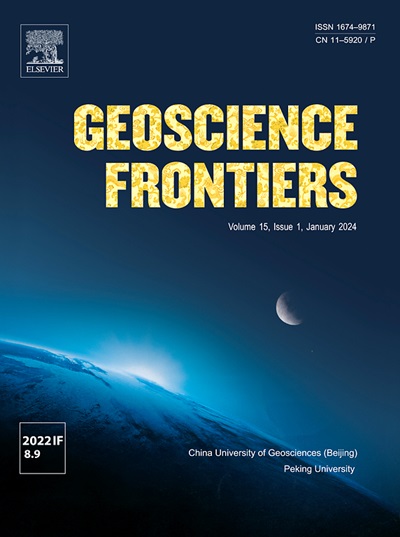玄武岩中的Nb/Ta-Dy/Yb系统揭示了大约22亿年前大陆岩石圈的一次增厚事件
IF 8.5
1区 地球科学
Q1 GEOSCIENCES, MULTIDISCIPLINARY
引用次数: 0
摘要
大陆岩石圈厚度显著影响地球的构造样式、克拉通的稳定、板内火山岩的组成和特定的成矿类型。虽然太古宙克拉通目前拥有地球大陆中最厚的岩石圈,但其厚度在整个地质历史中的演变仍然没有得到充分的理解。板块内小体积火山是现代地球上厚岩石圈大陆内部岩浆活动的典型产物,直到古元古代早期才出现,可能是由于地幔温度高而大陆岩石圈厚度不足所致。在这里,我们发现现代板内大陆玄武岩显示出Nb/Ta和Dy/Yb比值升高的独特特征,将它们与弧、裂谷和羽流环境中的玄武岩区分开来。我们对过去35亿年世界范围内玄武岩地球化学数据库的统计分析表明,自约2.2 Ga以来,现代类板内大陆玄武岩已经广泛存在。我们将大陆内玄武岩的出现归因于太古宙克拉通大陆内部的岩石圈增厚事件,这是由努纳超大陆组装过程中岩石圈的水平压缩造成的。本文章由计算机程序翻译,如有差异,请以英文原文为准。

A thickening event of the continental lithosphere ca. 2.2 billion years ago revealed by Nb/Ta-Dy/Yb systematics in basaltic rocks
Continental lithosphere thickness significantly influences Earth’s tectonic style, the stabilization of cratons, the compositions of intraplate volcanic rocks, and specific types of metallogenesis. Although the Archean cratons currently boast the thickest lithosphere among Earth’s continents, the evolution of its thickness throughout geological history remains inadequately comprehended. Intraplate small-volume volcanoes, typical products of magmatic activities within continents with thick lithosphere on the modern Earth, were rarely observed until the early Paleoproterozoic, possibly due to the high mantle temperature and insufficient thickness of the continental lithosphere. Here we show that the modern intraplate continental basalts exhibit distinctive signatures of both elevated Nb/Ta and Dy/Yb ratios, setting them apart from basalts found in arc, rift, and plume settings. Our statistical analysis of a geochemical database of basalts worldwide spanning the past 3.5 billion years indicates that modern-like intraplate continental basalts have become extensive since ca. 2.2 Ga. We attribute the emergence of intracontinental basalts to a lithospheric thickening event within the Archean craton continents, resulting from horizontal compression of the lithosphere during the assembly of the Nuna supercontinent.
求助全文
通过发布文献求助,成功后即可免费获取论文全文。
去求助
来源期刊

Geoscience frontiers
Earth and Planetary Sciences-General Earth and Planetary Sciences
CiteScore
17.80
自引率
3.40%
发文量
147
审稿时长
35 days
期刊介绍:
Geoscience Frontiers (GSF) is the Journal of China University of Geosciences (Beijing) and Peking University. It publishes peer-reviewed research articles and reviews in interdisciplinary fields of Earth and Planetary Sciences. GSF covers various research areas including petrology and geochemistry, lithospheric architecture and mantle dynamics, global tectonics, economic geology and fuel exploration, geophysics, stratigraphy and paleontology, environmental and engineering geology, astrogeology, and the nexus of resources-energy-emissions-climate under Sustainable Development Goals. The journal aims to bridge innovative, provocative, and challenging concepts and models in these fields, providing insights on correlations and evolution.
 求助内容:
求助内容: 应助结果提醒方式:
应助结果提醒方式:


